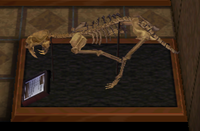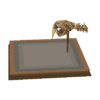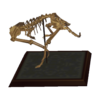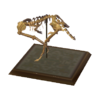Difference between revisions of "Sabertooth Tiger"
(Added NH image as new main, added gallery and included NH image and CF image) |
Trig Jegman (talk | contribs) m |
||
| (30 intermediate revisions by 9 users not shown) | |||
| Line 1: | Line 1: | ||
| − | |||
| − | |||
{{Infobox Fossil | {{Infobox Fossil | ||
|name = Sabertooth Tiger | |name = Sabertooth Tiger | ||
| − | |image = | + | |ja-name = スミロドン |
| − | |scientific name | + | |ko-name = 스밀로돈 |
| − | |sections | + | |zh-name = 剑齿虎 |
| − | |period | + | |zht-name = 劍齒虎 |
| − | |length | + | |fr-name = Smilodon |
| − | |price | + | |es-name = Tigre dientes de sable |
| − | + | |it-name = Smilodonte | |
| + | |de-name = Säbelzahntiger | ||
| + | |nl-name = Sabeltandtijger | ||
| + | |ru-name = Смилодон | ||
| + | |image = NH Sabertooth Tiger Museum.jpg | ||
| + | |caption = The Sabertooth Tiger in the museum in {{NH|nolink}}. | ||
| + | |scientific name = Smilodon fatalis | ||
| + | |type = Multi-part | ||
| + | |sections = Sabertooth Skull<br>Sabertooth Tail{{Note|Known as the Sabertooth Torso prior to {{NH|short|nolink}}.}} | ||
| + | |period = Pleistocene Cenzoic <small>({{WW|short|nolink}})</small><br>Quaternary <small>({{CF|short|nolink}})</small> | ||
| + | |length = 6.2 feet (1.9 meters) | ||
| + | |price = Skull: 2,500 [[Bell]]s<br>Tail: 2,000 Bells | ||
}} | }} | ||
| − | The '''Sabertooth Tiger''' ( | + | The '''Sabertooth Tiger''' (known as the '''Sabretooth Tiger''' in {{WW|short|nolink}}) is a two-part [[fossil]] in the {{SER}} introduced in {{WW}}. |
| − | == | + | ==At the museum== |
| − | ===In | + | ===In {{WW|short|nolink}}=== |
| − | + | [[File:WW Sabretooth Tiger Museum.png|thumb|left|The Sabretooth Tiger in the museum in {{WW|short|nolink}}.]] | |
| + | {{Blathers|WW|Hoo! Oh, hoo, how marvelous! I'm getting misty! The sabretooth tiger was an absolutely amazing beast! As its name implies, it was part of the cat family and had two long canine teeth. It could open its jaws incredibly wide, allowing it to tear into thick hides. It went extinct about 40,000 years ago...during a period when humans lived. I understand that humans also fell victim to this fierce hunter. The horror! Ah. Hoo. My apologies. I really should try to be more sensitive, eh wot?}} | ||
| − | + | {{Clear|left}} | |
| − | ===In | + | ===In {{CF|short|nolink}}=== |
| − | + | [[File:CF Sabertooth Tiger Museum.png|thumb|right|200px|The Sabertooth Tiger in the museum in {{CF|short|nolink}}.]] | |
| + | {{Blathers|CF|...We're witnesses to glory! The saber-toothed tiger is finished! Hootie WOOTIE! Such an event this is! As their name suggests, these fellows had two bug, swordlike teeth, and they were part of the cat family. They could open their jaws 180 degrees, allowing them to penetrate the thick hides of their prey! Savage! They went extinct 10,000 years ago...likely because there wasn't enough for them to eat! The mammoths they hunted were all eaten by humans instead, eh wot? HOO! I...beg your pardon! I was so enthralled, I... I spouted hot air like a boiling teapot, eh wot?}} | ||
| − | + | ===In {{NL|short|nolink}}=== | |
| + | After donating the final part of the fossil in {{NL|short}}, its plaque in the museum will read: | ||
| − | The | + | ''"The sabertooth tiger was about the size of a lion and is famous for its two long canine teeth. It would prey mostly on woolly mammoths, but climate change made that difficult. Eventually, the changing climate and competition with humans for food drove these creatures to extinction."'' |
| − | ===In | + | ===In {{NH|short|nolink}}=== |
| − | + | {{Blathers|NH|Chief actor in my most terrifying nightmares, the Sabertooth Tiger was a mighty predator of long ago. Its most famous feature, obviously, is its razor-sharp, eight-inch-long, t-t-te-tee-te-tee...FANGS! I'm sorry—this is so unprofessional of me. Come on, Blathers! Stiff upper beak, eh wot! While no one has seen a living specimen for some 10,000 years, we must remain ever vigilant!}} | |
| − | ===In | + | ==As an item== |
| − | + | ===In {{WW|short|nolink}}=== | |
| + | {{FossilContainer| | ||
| + | {{WWFossilInfo | ||
| + | | number = 31 | ||
| + | | name = sabertooth skull | ||
| + | | group = Sabretooth Tiger | ||
| + | | image = Sabertooth Skull WW Model.png | ||
| + | | sell = 2500 | ||
| + | | color1 = Brown | ||
| + | | color2 = Brown | ||
| + | | theme = Old-school | ||
| + | | width = 2.0 | ||
| + | | length = 2.0 | ||
| + | | hra = 1000 | ||
| + | }} | ||
| + | {{WWFossilInfo | ||
| + | | number = 32 | ||
| + | | name = sabertooth torso | ||
| + | | group = Sabretooth Tiger | ||
| + | | image = Sabertooth Torso WW Model.png | ||
| + | | sell = 2000 | ||
| + | | color1 = Brown | ||
| + | | color2 = Brown | ||
| + | | theme = Old-school | ||
| + | | width = 2.0 | ||
| + | | length = 2.0 | ||
| + | | hra = 1000 | ||
| + | }} | ||
| + | }} | ||
| − | ==In | + | ===In {{CF|short|nolink}}=== |
| − | + | {{FossilContainer| | |
| + | {{CFFossilInfo | ||
| + | | number = 31 | ||
| + | | name = sabertooth skull | ||
| + | | group = Sabertooth Tiger | ||
| + | | image = Sabertooth Skull CF Model.png | ||
| + | | sell = 2500 | ||
| + | | color1 = Brown | ||
| + | | color2 = Brown | ||
| + | | theme = Retro | ||
| + | | width = 2.0 | ||
| + | | length = 2.0 | ||
| + | | hra = 1000 | ||
| + | }} | ||
| + | {{CFFossilInfo | ||
| + | | number = 32 | ||
| + | | name = sabertooth torso | ||
| + | | group = Sabertooth Tiger | ||
| + | | image = Sabertooth Torso CF Model.png | ||
| + | | sell = 2000 | ||
| + | | color1 = Brown | ||
| + | | color2 = Brown | ||
| + | | theme = Retro | ||
| + | | width = 2.0 | ||
| + | | length = 2.0 | ||
| + | | hra = 1000 | ||
| + | }} | ||
| + | }} | ||
| − | {{ | + | ===In {{NL|short|nolink}}=== |
| + | {{FossilContainer| | ||
| + | {{NLFossilInfo | ||
| + | | name = sabertooth skull | ||
| + | | group = Sabertooth Tiger | ||
| + | | image = Sabertooth Skull NL Model.png | ||
| + | | sell = 2500 | ||
| + | | color1 = Brown | ||
| + | | color2 = Brown | ||
| + | | theme = Quirky | ||
| + | | width = 2.0 | ||
| + | | length = 2.0 | ||
| + | }} | ||
| + | {{NLFossilInfo | ||
| + | | name = sabertooth torso | ||
| + | | group = Sabertooth Tiger | ||
| + | | image = Sabertooth Torso NL Model.png | ||
| + | | sell = 2000 | ||
| + | | color1 = Brown | ||
| + | | color2 = Brown | ||
| + | | theme = Quirky | ||
| + | | width = 2.0 | ||
| + | | length = 2.0 | ||
| + | }} | ||
| + | }} | ||
| − | == | + | ===In {{NH|short|nolink}}=== |
| − | {| | + | {{FossilContainer| |
| − | | | + | {{NHFossilInfo |
| − | + | | name = sabertooth skull | |
| − | + | | group = Sabertooth Tiger | |
| − | + | | image = Sabertooth Skull NH Icon.png | |
| − | + | | interactable = No | |
| − | | | + | | sell = 2500 |
| − | + | | color1 = Brown | |
| − | | | + | | color2 = Brown |
| − | | | + | | width = 2.0 |
| − | | | + | | length = 2.0 |
| − | | | + | }} |
| − | | | + | {{NHFossilInfo |
| − | | | + | | name = sabertooth tail |
| − | | Brown | + | | group = Sabertooth Tiger |
| − | | | + | | image = Sabertooth Tail NH Icon.png |
| − | |} | + | | interactable = No |
| + | | sell = 2000 | ||
| + | | color1 = Brown | ||
| + | | color2 = Brown | ||
| + | | width = 2.0 | ||
| + | | length = 2.0 | ||
| + | }} | ||
| + | }} | ||
| − | + | ==Real-world information== | |
| + | ''Smilodon'' lived in the Americas during the Pleistocene, 2.5 million to 10,000 years ago. While commonly called the "saber-toothed tiger", it is not closely related to tigers or modern cats. Despite this, modern felines do share a very distant ancestor with Smilodon. Three species are known: ''S. gracilis'' (the smallest and likely the first to evolve) and ''S. fatalis'' (the most well-known) from North America, and ''S. populator'' (the largest and first discovered) from South America. They were more robustly built than modern cats, and their teeth were adapted for precision killing. The diet of the North American species included bison and camels. Their extinction has been linked with the disappearance of Pleistocene megafauna (possibly due to the arrival of modern humans) and the evolution of smaller, more agile herbivores like modern deer. | ||
| − | + | {{See Wikipedia|Smilodon}} | |
| − | |||
| − | |||
| − | |||
| − | {{ | + | ==Notes== |
| + | {{Note list}} | ||
| + | {{Navbox Fossil}} | ||
[[Category:Wild World fossils]] | [[Category:Wild World fossils]] | ||
[[Category:City Folk fossils]] | [[Category:City Folk fossils]] | ||
[[Category:New Leaf fossils]] | [[Category:New Leaf fossils]] | ||
[[Category:New Horizons fossils]] | [[Category:New Horizons fossils]] | ||
Latest revision as of 15:23, March 11, 2024
The Sabertooth Tiger (known as the Sabretooth Tiger in Wild World) is a two-part fossil in the Animal Crossing series introduced in Animal Crossing: Wild World.
At the museum[edit]
In Wild World[edit]
In City Folk[edit]
In New Leaf[edit]
After donating the final part of the fossil in New Leaf, its plaque in the museum will read:
"The sabertooth tiger was about the size of a lion and is famous for its two long canine teeth. It would prey mostly on woolly mammoths, but climate change made that difficult. Eventually, the changing climate and competition with humans for food drove these creatures to extinction."
In New Horizons[edit]
As an item[edit]
In Wild World[edit]
| Sabertooth skull | |
|---|---|
| Sell price | |
| Colors | Brown
Brown
|
| HRA genre | Old-school |
| Size | |
| Sabertooth torso | |
|---|---|
| Sell price | |
| Colors | Brown
Brown
|
| HRA genre | Old-school |
| Size | |
In City Folk[edit]
| Sabertooth skull | |
|---|---|
| Sell price | |
| Colors | Brown
Brown
|
| HRA genre | Retro |
| Size | |
| Sabertooth torso | |
|---|---|
| Sell price | |
| Colors | Brown
Brown
|
| HRA genre | Retro |
| Size | |
In New Leaf[edit]
| Sabertooth skull | |
|---|---|
| Sell price | |
| Colors | Brown
Brown
|
| Style | Historical |
| HHA theme challenge | Quirky |
| Size | |
| Sabertooth torso | |
|---|---|
| Sell price | |
| Colors | Brown
Brown
|
| Style | Historical |
| HHA theme challenge | Quirky |
| Size | |
In New Horizons[edit]
| Sabertooth skull | |
|---|---|
| Interactable | No |
| Sell price | |
| Colors | Brown
Brown
|
| Size | |
| Sabertooth tail | |
|---|---|
| Interactable | No |
| Sell price | |
| Colors | Brown
Brown
|
| Size | |
Real-world information[edit]
Smilodon lived in the Americas during the Pleistocene, 2.5 million to 10,000 years ago. While commonly called the "saber-toothed tiger", it is not closely related to tigers or modern cats. Despite this, modern felines do share a very distant ancestor with Smilodon. Three species are known: S. gracilis (the smallest and likely the first to evolve) and S. fatalis (the most well-known) from North America, and S. populator (the largest and first discovered) from South America. They were more robustly built than modern cats, and their teeth were adapted for precision killing. The diet of the North American species included bison and camels. Their extinction has been linked with the disappearance of Pleistocene megafauna (possibly due to the arrival of modern humans) and the evolution of smaller, more agile herbivores like modern deer.
More information on this topic is available at Wikipedia.
Notes[edit]
| Fossils | ||||||||||||||||||||||||
|---|---|---|---|---|---|---|---|---|---|---|---|---|---|---|---|---|---|---|---|---|---|---|---|---|
| ||||||||||||||||||||||||











